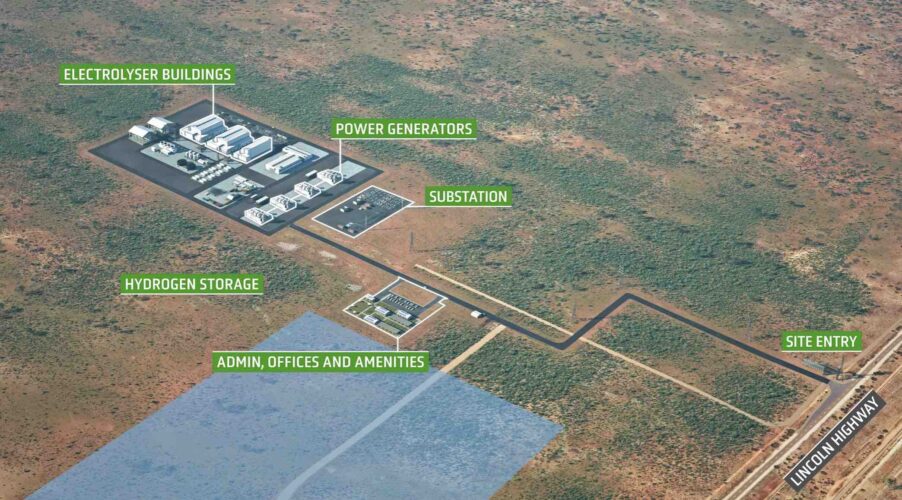The South Australia Labor government has announced the potential winners of its landmark green hydrogen tender, which will see the construction of a 250 MW electrolyser and a 200 MW hydrogen gas generator that will be key to managing its accelerating shift towards 100 per cent renewables.
The government on Sunday named a consortium of international gas and engineering giants Atco and BOC Linde as the “preferred partners” to what the state calls its Hydrogen Jobs Plan, which is backed by $593 million of state funding.
The two companies were chosen from 29 competing proposals, with Epic Energy, a gas pipeline company that is branching out into large scale solar projects, providing the hydrogen storage capabilities. A final agreement is dependent on further studies to be conducted over the next six months.
The new projects – the biggest of their type in the world – will be built in Whyalla and will be crucial in helping the state and market operator manage the growing share of wind and solar in the grid, which regularly delivers more than 100 per cent of state demand, and which reached a potential 264 per cent on Saturday, before curtailment.
The electrolyser will help soak up excess renewables, particularly in the middle of the day when rooftop solar output alone is sufficient to meet all state demand on occasions, while the hydrogen gas generator will operate as a “peaking” plant to meet demand peaks in the evening and other times.
The green hydrogen will also be used to deliver zero carbon solutions to hard to abate industries, with the state government pointing to the possibilities of a major push into “green iron”.
“This is a world-leading opportunity for South Australia, that has the potential to rival Victoria’s gold rush, the coal boom in Queensland, or Western Australia’s development of iron ore and gas,” state premier Peter Malinauskas said in a statement.
“We have all the things the world will need to decarbonise – abundant copper and magnetite, the world’s best coincident wind and solar resources, world-leading renewable energy penetration and soon, the ability to harness this abundant clean energy in the form of hydrogen.
“We can use this clean hydrogen to firm our electricity grid, but more than that, we can use it to help reindustrialise the Upper Spencer Gulf, creating thousands of jobs in the process.”
The announcement follows a six month assessment process that was due to be completed in the September quarter. The timeline for completion has also slipped, and the state is now targeting “early 2026” rather than December, 2025.
State energy minister Tom Koutsantonis says the green hydrogen will also be used by other customers, helping decarbonise industry in the state, and for potential exports. The state is looking to develop a massive green hydrogen and green ammonia export hub at Port Bonython, near Whyalla.
“For two decades South Australia has shone bright in the race to 100% net zero, thanks in part to our exceptional sun and wind resources to generate renewable power,” Koutsantonis said in a statement.
“The Hydrogen Power Plant in Whyalla continues this momentum, and our world leadership using hydrogen for renewable energy storage, and enabling us to ship the sun beyond our shores.”
The electrolyser and generator will both be owned and operated by the state. The demand created by the electrolyser will mean less curtailment of large scale wind and solar, and a value tool to help AEMO deal with its new big headache – how to deal with significant drops in operating demand.
Koutsantonis also said, in an interview with RenewEconomy’s Energy Insiders podcast (to be published on Monday) that the generator will bid into the market at the marginal cost of generation.
He says this will help moderate wholesale electricity prices in the demand peaks.
“I accept that there are some people who might be cautious about it, it’s just solely as an energy source,” Koutsantonis says.
“But my view is we’re only producing renewable energy now. That overproduction is leading to either export interstate, and when that’s our capacity, we basically turn it off.
“And I think that’s just completely unjustifiable solution. So what we’ve decided to do is invest our money to try and prove up electrolysis at grid scale can be done effectively and cheaply with the overproduction of renewable energies.
“And then you can use that energy to firm renewable energy into the grid. What we’re all paying for through higher power prices, isn’t renewable energy, it’s the gap.
“And the gap is becoming more and more expensive, the smaller and smaller it gets … because (the gas generators) are trying to extract that same amount of rent over a smaller period of time.”
Koutsantonis says that because the hydrogen plants will have multiple purposes and multiple revenue streams, and because they are state owned, they will be able to bid into the market at lower prices, to cover their production costs.
Koutsantonis says the green hydrogen capabilities, the ample wind and solar resources in the state, and the its reserves of magnetite iron ore meant a huge opportunity for the state to export “green iron” in significant quantities to help the global steel industry slash emissions.
“I think we will see exports of green iron well before we see exports of green hydrogen,” he told the Energy Insiders podcast.
John Ivulich, the CEO and country head of ATCO Australia, said the “world’s biggest hydrogen plant” in Whyalla will unlock decarbonisation opportunities and enhance prosperity for generations.
“ATCO is committed to the energy transition across the globe and our combined expertise at energy, partnering and delivery over many decades makes this project a significant milestone in our history,” he said in a statement.











